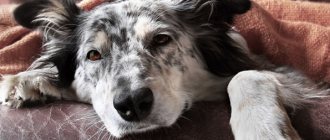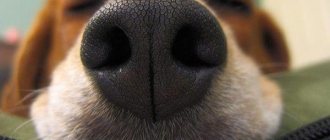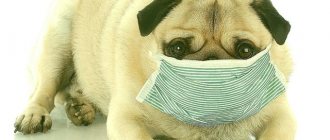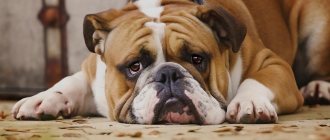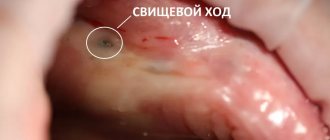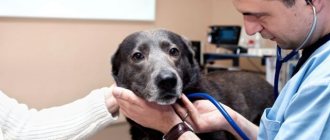The nose of a healthy dog
- The tip is cold.
- Moderately humid.
- The exhaled air is uniform, of medium strength and symmetrical from both nostrils.
- The color of the mucous membrane is pale pink, changing to pink-red when excited.
- No cuts or cracks.
- No swelling, overlays or ulcers.
- No discharge (snot).
Dryness is explained by limited sweat production or its complete cessation.
A decrease in the secretion of glands can occur in diseases that occur with a large loss of water from the body. Wet and cold skin becomes dry and hot (cold) to the touch, and with prolonged illness, cracks and crusts appear.
Physiology of the dog's nose
The sensitivity of a dog's sense of smell is explained by the unusual structure of the organ. Unlike a human's, a dog's nose is equipped with four holes: front and side. This structure eliminates the mixing of odors. Inhaled air enters through the nostrils, and exhaled air exits through holes located on the sides.
Another feature is the mucous film covering the outer and inner surfaces of the olfactory organ. It not only increases sensitivity, but also performs an antibacterial function.
Possible causes of dry nose
- A dog's nose may become dry if the room temperature is too high (heat). Also, at excessively low temperatures (frost, wind), dry skin will be noted.
- During sleep, the animal's body temperature rises, i.e. becomes higher than normal, which leads to evaporation of moisture.
- If you were engaged in training or outdoor games with the dog.
- In puppies or in mature dogs. But, you need to take into account that in old age, dryness in a dog can lead to tissue diseases, which occurs due to metabolic disorders, and this is already a pathological case.
- Change of place of residence, environment or experience of shock in animals.
- Dryness can be passed on from generation to generation.
- During estrus, pregnancy and feeding puppies, the reason is hormonal changes in the body.
- A poorly designed diet that contains a lack of any microelements, vitamins and minerals.
- Insufficient fluid intake.
- Species, gender, age, different metabolism and much more.
All the reasons described above should lead to dryness for a short period of time, no more than two hours.
If the manifested symptom does not disappear, or, moreover, additional symptoms appear that are not inherent in the normal and healthy behavior of the animal, then this indicates unfavorable, pathological changes in the dog’s body.
Why should your nose be wet and cool?
On the mucous membrane of a dog's nose, which lines its internal cavity and external lobe, there are so-called nasal glands that produce a special secretion. Thanks to this, the olfactory organ is always moist and cool. This is necessary, because this is how thermoregulation occurs. The fact is that the dog's body has a very small number of sweat glands. They are found on the paw pads and in the ear canals. Additional cooling occurs due to the respiratory organ.
In addition, a constantly moist surface of the nose ensures its maximum sensitivity. The dog is able not only to perceive the subtlest odors, but also to sense air movement. At the same time, she understands where their source is and divides the entire spectrum of aromas into their constituent components.
A healthy, active pet should have a moist, cool nose, which allows it to remove excess heat and distinguish odors in the best possible way. When a dog has a dry and warm nose, this makes the owner think that he is sick. Indeed, in some cases this is true, but not always.
Symptoms of pathological diseases
The symptom of dry nose in pathological conditions and diseases of the animal’s body does not appear alone. Along with it, various kinds of symptoms appear, depending on the type of disease, such as:
- low and high apical temperatures;
- loss of appetite;
- lethargy;
- redness of the eyes;
- violations of integrity (cracks, ulcerations, swelling);
- expiration;
- sneezing;
- cough and many others.
It is necessary to take into account that the “collection” of some symptoms may indicate either one specific disease or several completely different ones.
The main causes of pathological diseases and their symptoms:
1. Spending time outside or in the house, a dog can introduce a foreign body into its body, or cause injury (dry and hot nose).
2. With an insufficient amount of fluid entering the body, the dog can easily be led to a pathological condition (dry and hot nose).
3. If there is severe loss of fluid, for example with vomiting, frequent urination, or loose stools, dehydration will also occur (dry nose, lethargy and high temperature).
4. Some types of allergies in dogs: food, to flea saliva or to environmental substances (dry nose, snot, red eyes).
5. Lack of vitamins in dogs is expressed in the form of vitamin deficiency and hypovitaminosis (dry and cracked nose, lethargy).
6. Intake of toxins (dry and hot nose, lethargy).
7. Infection with helminths and their eggs (lethargy and dry nose).
8. In case of infection (dry and hot nose, snot flowing).
9. Autoimmune skin disease (papules and pustules, erosions and yellow crusts form, a cracked nose, the dog does not eat and the nose is dry).
10. Canine distemper (redness of the eyes, the dog’s nose becomes dry and flaky).
11. Interstitial nephritis (dry and hot nose).
12. The postoperative period may involve dehydration (dry and hot nose).
There's no reason to worry
In what cases is a warm and dry nose not a cause for concern?
Age or individual characteristics of the pet
It is not uncommon for small puppies to have warm noses. If in general nothing has changed in the baby’s behavior, then there is no need to worry. The puppy will grow up, and everything will return to normal.
There are cases when some dogs always have a warm nose. This is already an individual feature. It’s just that the nasal mucosa in such animals is “passive”. And for them this is the norm.
The dog is sleeping or has just woken up
Pets that lead a calm and measured life lose the need for anxiety and a sensitive state during sleep. They do not need to be constantly on the alert, worry and catch with their nose the slightest changes in the environment. They sleep calmly and peacefully. The nose is also resting. Therefore, during sleep, the nose is dry. But as soon as the mustache wakes up, everything immediately returns to normal.
Overwork
For several hours in a row, your four-legged animal actively swam, ran and jumped. And when he returned home, he “fell without his hind legs” and does not react to anything. And the nose is dry and warm.
Don’t worry, it’s just that your little toothy has lost strength due to active pastime. He'll rest a little and everything will be fine again.
Stress
A dog can also have a dry nose when it is afraid of something or is nervous. Monitor your pet's emotional state. Try to provide him with the most comfortable and calm environment possible.
Weather
Extreme heat or cold can also cause a dry, warm nose. Under the scorching rays of the sun, the skin on a dog's nose, like a person's, can burn.
In extreme heat, try to provide the animal with the most comfortable conditions possible: shade, plenty of drink and access to water. How to do this, read about how to protect your dog in the heat.
The same applies to severe cold. Severe frost can cause your nose to become dry and even cracked.
Microclimate in the house
Sudden temperature changes, air conditioning and heating very dry the skin. If the air in the apartment is dry, not only the dog, but also everyone in the household will have problems with dry skin.
Pregnant or lactating bitches
A warm and dry nose in pregnant or lactating bitches is considered normal.
We've looked at cases where a warm, dry nose is not a cause for concern. Now let's talk about when a pet's dry nose is a sign of a particular disease.
Prevention
In order to avoid the risk of disease, you need to know about the preventive measures that the owner himself can carry out and support. The most important thing is to always be attentive to your pet and take proper, complete and proper care of it.
- It is necessary to monitor walking areas located outside the living quarters. Dirt is a kind of storage and cause of various kinds of infections and parasitic diseases. There may be debris, metal objects, glass shards, plastic that the dog can eat or injure itself.
- It is necessary to control contacts with other animals: stray dogs, cats, hedgehogs. These are potential carriers of infections and diseases, and in some cases, they can infect a dog with rabies.
- If the weather is hot, then reduce the time you spend outside, or find a place where direct sunlight will not penetrate.
- Always have a bottle of water with you so that your pet can always quench its thirst.
- Try not to take your dog to places where there may be sources of allergies.
- If the time of winter weather has come, then you should reduce your time spent outdoors, or use special clothing for animals.
- After a walk, you should always bathe the animal to destroy pathogenic microflora brought with dirt.
- Create a comfortable temperature in the room and eliminate drafts. Monitor the cleanliness and hygiene of the premises and ensure a favorable environment.
- The dishes must be clean, food and water must be fresh, of high quality and properly selected.
- Change the water every day and make sure there is always plenty of it.
- And most importantly, carry out annual vaccination and deworming (anthelminthic therapy) of your pet. To do this, you need to contact a veterinary clinic so that the doctor examines the animal and advises the owner about everything that concerns his dog.
Signs of diseases in the nose
If we are talking about a really important problem related to the pet’s health, as a rule, other characteristic symptoms are added to it. To understand what exactly is causing dryness, you must first monitor the animal’s condition and understand what symptoms it exhibits. Below is a list of the most common diseases that are characterized by a dry nose.
Allergy
If the allergy is seasonal, this can be traced to the time of year when symptoms appear. This usually happens during the flowering period of plants. If allergic reactions occur constantly, it is quite difficult to determine their source on your own. Potential threats include:
- diet;
- chemicals;
- house plants;
- things made from wool;
- dust.
First of all, it is important to change the type of food your dog eats. It is preferable to use hypoallergenic food to determine whether the disease is caused by the diet. If the symptoms do not disappear, you should look in a different direction.
Cleaning the house should be done more often and household chemicals should not be used. Wash your pet's bowls only with warm water, without using any special products. Wool bedding should be replaced with cotton. If you are unable to identify the allergen yourself, contact your veterinarian for advice. With allergic reactions, dogs have red eyes, sneezing, and a runny nose, but in general the dog is cheerful and feels normal.
Injuries
If your pet is injured, you should immediately provide first aid.
Do not use iodine, alcohol or other disinfectants in the nasal area. This is fraught with burns to the mucous membrane.
Inflammation may develop in the injured area, causing the nose to become completely dry. Usually the dog constantly lies down and does not show activity, but does not lose its appetite, the animal will soon recover.
Infections
One of the most dangerous infectious diseases is rabies. It is dangerous for unvaccinated dogs and is transmitted through the saliva of a sick animal. First symptoms:
- hot, very dry nose;
- poor appetite;
- lethargy;
- active salivation;
- vomit;
- fear of light.
At the same time, the animal drinks a lot. Unfortunately, it is impossible to treat rabies; an infected pet must be euthanized.
Cold
Usually, with a mild cold, owners try to treat it at home. But the dog should still be examined by a veterinarian to rule out the development of pneumonia. If your pet shows signs of a cold, owners need to do the following:
- Give the dog some rest. The animal should have warm water and favorite food nearby that will definitely not be rejected. There are often cases when a sick pet has no appetite, but it is necessary to eat well during a cold.
- Eliminate drafts. The resting place of a sick animal should not be too hot or cold, and all open windows and doors should be closed. Room temperature is optimal to make the dog comfortable.
- Reduce walking time. A sick pet needs to relieve itself, so it needs to be taken outside for a short time. The maximum time spent there should be no more than 15 minutes.
If your pet does not get better, and wheezing is added to the cough, you should definitely consult a veterinarian. Typically, in such cases, antibiotics are prescribed in combination with drugs to maintain the normal state of intestinal microflora.
Due to a cold, the animal may develop crusts in its nose, causing discomfort. A nose with crusts should be treated with hydrogen peroxide and then carefully removed. Do not rip them off dry: this can lead to wounds on the nose and further infection.
Pemphigus
This disease is characterized by disruptions in the immune system that cause blisters to appear on your pet's nose. There is liquid inside them that flows out as soon as the bubble bursts. After this, you can see how the nose is covered with a dry crust and becomes very rough. The crust is usually localized throughout the nasal passage, causing the dog to have difficulty breathing. In addition to specific treatment aimed at restoring immunity, you can smear your nose with calendula ointment to soften cracks.
Worms
Another dangerous disease that can not only undermine the health of the animal, but even cause death. Characteristic symptoms:
- protruding peritoneum;
- constipation;
- apathy;
- high or low temperature;
- dry nose.
To prevent the appearance of worms, it is necessary to carry out regular deworming.
Plague
The disease is characterized by a high rate of progression and a high percentage of deaths in the later stages of the disease. The infected dog is lethargic, does not eat, and shakes as if he is freezing. Diarrhea, vomiting, pus from the nose, as well as indifference to food and water are often observed. Self-medication can be dangerous, so at the first sign it is necessary to show the animal to a doctor.
Treatment
In case of injury. It is necessary to stop the bleeding. Identify the cause and location of the injury and disinfect the area. If necessary, administer anesthetic and apply stitches. Take medication that will promote further healing. Preparations: Lysozyme, Travmatin, Ranosan, etc.
When dehydrated. Force drink water using a syringe. Apply a dropper with glucose solution. If necessary, then medications.
For allergies. If you have a food allergy, then choose a diet that excludes those foods that cause an allergic reaction. If you are allergic to fleas, use collars and special shampoos. With Atopic allergies, the animal cannot be cured, but with the use of certain medications, vital signs can be improved. Medicines: Antihistamines.
With vitamin deficiency. Review and recalculate the animal’s diet, balancing it.
In case of poisoning. It is possible to wash the gastrointestinal tract with potassium permanganate. Preparations: vitamin B6, adsorbents.
For helminths. Anthelmintics.
For colds. Depending on the type of cold, take certain medications. Medicines: antibiotics, vitamins, immunostimulants, anti-inflammatory and expectorants.
Pet owners should understand that self-medicating their pet is very dangerous, this can lead to a deterioration in its condition, or, in the worst case, death.
What to do and how to help your pet
First of all, you need to determine the cause of dryness. To do this, gradually eliminate all possible related factors. Most likely, the reason lies in the natural reaction of the body and does not require outside intervention. The pet needs to create conditions for recovery. Give drink, calm, provide rest and peace.
If additional symptoms are revealed during examination and observation, it is best to take the dog to see a veterinarian. Some medications can only be used as prescribed by a doctor. It should be remembered that an incorrectly prescribed course and dosage can aggravate the situation. Therefore, self-medication is extremely undesirable.
At the appointment, problems and symptoms cannot be hushed up. Collecting medical history (information) is very important for making a diagnosis. It is necessary to remember and provide the doctor with all the necessary information. If the dog, for example, belongs to friends, grandmother, parents, then you need to prepare in advance for the survey and find out all the details about care, feeding and maintenance. You should also not wipe off the discharge or give medications. This can blur the picture of the disease.
When to see a doctor:
- Increase or decrease the temperature by 1–2 °C. The norm depends on the breed and age, ranging from 37 to 39 °C.
- Violation of urination and defecation, such as a decrease in the daily norm, constipation, diarrhea, pain and other abnormalities.
- Refusal of food and water.
- Vomiting, constant retching.
- Pain on palpation (palpation).
- Blood in urine, feces, vomit.
- Lethargy, apathy, weakness. Lack of response to external stimuli.
- Muscle tremors.
- Drooling, foam.
- Convulsions, loss of coordination.
- Paleness or hyperemia of the mucous membranes.
- Copious purulent discharge from the nose and eyes.
- A sharp change in mood from cowardice to aggression.
- Photophobia, hydrophobia.
- Loss of consciousness.
- Rapid breathing and heart rate at rest.
- Shortness of breath, severe coughing and sneezing.
- Paralysis of limbs.
After diagnosis and test results, the doctor will prescribe a course of treatment and preventive procedures. It is necessary to adhere to the recommendations and follow the instructions received. Any deviations may cause an exacerbation of the disease or reduce the therapeutic effect.
Treatment methods:
- Antiviral and antibiotics are prescribed for infectious and viral diseases.
- Sedatives to suppress fear and stress.
- Anthelmintic drugs.
- In case of poisoning, rinsing and immunostimulating drugs are prescribed.
- Vaccination for preventive purposes.
- Surgical intervention to eliminate tumors, injuries, kidney stones, etc.
- Antihistamines for allergic reactions. This therapy only works when the allergen is eliminated.
- Adjustment of diet, diet.
- A course of vitamins to maintain the body and treat vitamin deficiencies.
During treatment and rehabilitation, it is necessary to provide the pet with suitable care and care. The dog should be protected from drafts and overheating. And also keep the bowls and room clean.
Briefly about the main thing
- A healthy dog's nose is cold and moderately moist.
- Dryness is explained by limited sweat production or its complete cessation, but does not always signal illness.
- The symptom of dry nose in pathological conditions and diseases of the animal’s body does not appear alone.
- To prevent the risk of disease, you need to regularly monitor walking areas, the amount of fluid consumed, and also prevent overheating or hypothermia.
- If a problem occurs, you should immediately contact a specialist.
What should the owner do?
When making a decision, consider the condition of the pet. If it is satisfactory, then you can help yourself.
At home
Don't panic if there are no alarming symptoms. The consequences of harmless causes go away on their own, so try to relax and observe.
If you feel lethargic and have poor appetite, take your temperature. Minor deviations can be corrected by drinking plenty of fluids, ventilating or wrapping up. Use simple and safe methods, avoiding taking antipyretic drugs - such treatment can aggravate the animal’s condition, so it is better to entrust the choice of medications to a veterinarian.
To eliminate dryness, use a softening ointment or cream with chamomile and calendula. They will prevent cracks from appearing. The same products are suitable for healing wounds after injury.
General recommendations
So, every dog owner should understand that if the dog’s nose is dry and hot, you should not immediately run to the veterinarian. You just need to carefully observe the behavior of your ward. If the behavior does not change, the animal is active and mobile, eats with appetite, then there is nothing to worry about. If deviations in the condition of the nose are accompanied by a pronounced change in the physiological balance of the animal, then it is worth looking for the reason that caused it, calling on the professional experience of a veterinarian to help. He will help make the correct diagnosis and prescribe the correct treatment.
In order for your pet to always be in excellent condition, you need to regularly perform the same actions: avoid dehydration, diversify the menu, regularly walk it, clean it from parasites every quarter. It is important not to use hygiene products that can cause an allergic reaction, to maintain optimal temperature conditions for living (so that it is neither too cold nor too hot), and if the inflammatory process begins, immediately seek medical help.
Currently reading:
- 6 Factors for a Cold or Wet Dog's Nose
- Seven Signs and Remedies for Getting Rid of Fleas in Dogs
- How and with what to treat a runny nose or rhinitis in dogs
- Tips for proper dog burial
